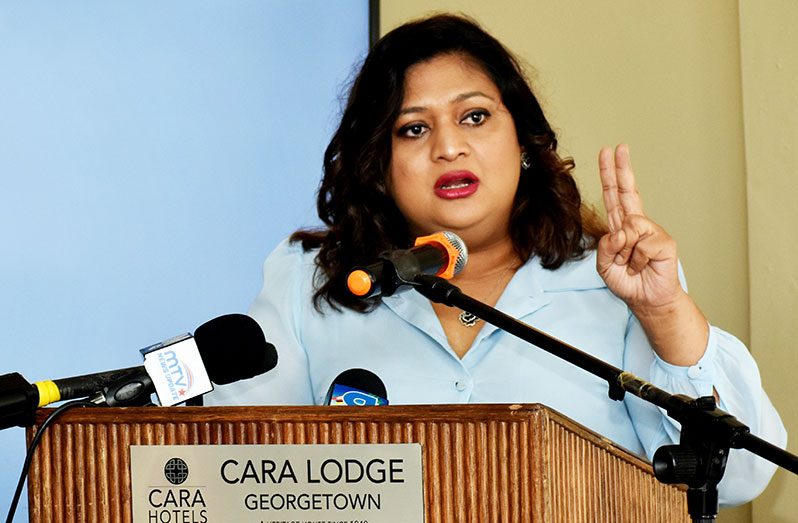-says Minister Manickchand
EVEN though vaccination numbers for adolescents, aged 12 to 18, remain low, Minister of Education, Priya Manickchand, has made it clear that government has no plans to continue keeping children out of school and will be moving ahead with the commencement of face-to-face learning for Grades 8 to 13 on January 03, 2022.
Minister Manickchand, at a media engagement on Monday, disclosed that the vaccination rate for this age group remains at just over 30 per cent. She emphasised that government does not intend to allow these numbers to hinder the safe return to face-to-face learning.
“My thinking behind reopening fully in these levels is whoever was going to take the vaccine could have taken it by now… if persons are not going to take the vaccine, then we cannot keep our children out of school and it is unfair to the children who took the vaccine that they’re unable to access schooling,” said Minister Manickchand.
Government began the roll out of the Pfizer-BioNTech COVID-19 vaccine for children aged 12 to 18 on August 26, 2021. The target was some 50,000 students in the secondary school system.
Schools in Guyana had first closed their doors in March 2020, as a result of measures implemented by the government to curb the spread of the virus. The closure and the subsequent partial reopening of school have severely affected education delivery in Guyana.
Public schools in Guyana are currently using customized rotational openings, which started in September. Before this, schools were closed for a lengthy period, and learners were exposed to virtual learning.
“We intend to vigorously get back to a level of normalcy that we have still not been able to do. So except we are otherwise advised by the Ministry of health, all students from Grades 8 to 13 will be expected to go back to school full time,” said Minister Manickchand.
TEACHERS READY
Meanwhile, the Education Minister stated that she is confident that an overwhelming majority of secondary school teachers are ready to resume face-to-face learning.
She disclosed that over 70 per cent of teachers in the school system are already vaccinated against COVID-19, signalling their readiness to engage their students.
“We expect that we are going to see a very high turnout of both students and teachers and we are saying, at the same time, that while we are asking students to return that we are not mandating it.”
Minister Manickchand further reminded that, once schools reopen on January 3, 2022, all resources inclusive of worksheets and tutorials will remain on the ministry’s websites for students whose parents do not wish for them to return to the classroom.
“All of the resources we have will remain online for any student who chooses not to come to school for face-to-face learning. We have been fully opened for face-to-face learning for Fourth, Fifth, and Sixth Forms, and students, with and without the vaccine, have been coming to those classes and I suspect that same position will be mirrored from Grade Eight upward,” said Minister Manickchand
SEVERE IMPACT
According to a World Bank, UNESCO, and UNICEF a report released on December 8, 2021, this generation of students now risks losing $17 trillion in lifetime earnings in present value, or about 14 per cent of today’s global Gross Domestic Product (GDP), as a result of COVID-19 pandemic-related school closures.
The new projection reveals that the impact is more severe than previously thought, and far exceeds the $10 trillion estimate released in 2020.
In addition, ‘The State of the Global Education Crisis: A Path to Recovery’ report shows that, in low- and middle-income countries, the share of children living in learning poverty – already 53 per cent before the pandemic – could potentially reach 70 per cent, given the long school closures and the ineffectiveness of remote learning to ensure full learning continuity during school closures.
Simulations estimating that school closures resulted in significant learning losses are now being corroborated by real data, the report noted. For example, regional evidence from Brazil, Pakistan, rural India, South Africa, and Mexico, among others, show substantial losses in mathematics and reading.
Analysis shows that, in some countries, on average, learning losses were roughly proportional to the length of the closures. However, there was great heterogeneity across countries and by subject, students’ socioeconomic status, gender, and grade level.
For example, results from two states in Mexico showed significant learning losses in reading and in mathematics for students aged 10-15. The estimated learning losses were greater in mathematics than reading and affected younger learners, students from low-income backgrounds, as well as girls disproportionately, according to the report.
Barring a few exceptions, the general trends from emerging evidence around the world align with the findings from Mexico, suggesting that the crisis had exacerbated inequities in education.
The report further stressed that reopening schools must remain a top and urgent priority globally to stem and reverse learning losses. Countries should put in place Learning Recovery Programmes with the objective of assuring that students of this generation attain at least the same competencies of the previous generation.
Programmes must cover three key lines of action to recover learning: consolidating the curriculum, extending instructional time and improving the efficiency of learning.




.jpg)









